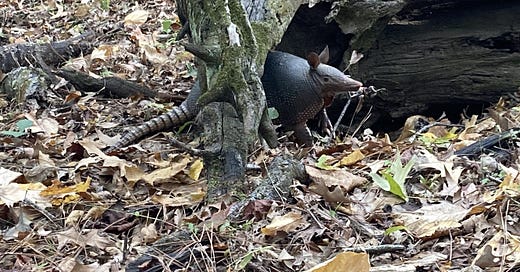Nuisance Animals
Who are they really, the "outlaw quadrupeds" or the bipeds who make up the laws?
Once we made the decision to move out of the city, I started to dig up and pot several favorite herbs and native plants from our yard. More than 20 containers clustered in sun-loving and shade-tolerant groups. I loved them and wanted to take some with me to our new home, wherever that would be.
Fraying toward disintegration because of the relentless noise and hypergentrification around me, I needed—not wanted—to live surrounded by Nature and away from other humans to the greatest degree possible. The house and land that ultimately matched enough of what The Renaissance Man and I both prioritized turned out to be on the outskirts of a wildlife management area, within a forest with no neighbor within easy view in any direction.
Our place’s previous owners left behind a fenced dog run, and that’s where I stored my plants through the winter and early spring after we moved. We watched the white-tailed deer herd graze through the mowed section of the front yard, glad we’d found a place where no shooting or hunting was allowed according to law.
Yeah, right.
Living in Baton Rouge, I heard gunfire more often than I do in the woods. The sound still makes me startle and the intent still makes me sick. Before I moved, I knew bears, bobcats, coyotes, and other potentially dangerous animals were among the trees. A human might have to protect their life somehow.
Soon enough, I’d discover a presumed threat wasn’t always why I heard shots.
The first spring, I planted what I’d taken with us only to find out the deer really do eat almost everything. They had no interest in rosemary, oregano, and mint, but the rest they nibbled to stems. I moved the old dog run under a group of trees near the porch and transplanted what I could within it. Instead of fighting the deer, I decided I’d find out what would grow that they didn’t like—adaptation rather than force—well aware I was in their space now.
Within a few weeks, as we found out more about the densely wooded area we’d moved into, I learned
one neighbor shot a deer who ate his roses;
one shot the armadillos who dug around his yard;
one shot the feral hogs who roamed wild; and
several shot snakes who crossed their paths.
That summer, the man who shot the hogs told The Renaissance Man—as the neighbor shared vegetables he’d grown—he poisoned the raccoons who climbed into his garden enclosure. Got nine of them! When my husband informed me of this, I threw the squash into the woods, which no animal touched and it rotted where it lay.
Yes, the balance in nature has been disrupted so much that humans must intervene. Great thought, tireless research, and many meetings must have taken place to create the list of Louisiana animals that are fair game: the “outlaw quadrupeds”—armadillos, coyotes, and feral hogs; the general nuisances—bats, beavers, bobcats, foxes, minks, muskrats, nutrias, opossums, otters, rabbits, raccoons, skunks, snakes, and squirrels; and the ones that require other permitting to remove—alligators, bears, deer, and migratory birds.
State law, Title 76, Section V-125, outlines the allowable “…control of the wild quadrupeds listed [in the statute] and only when they are conclusively proven to be creating a nuisance or causing damage to property. The burden of establishing that the animal in question is causing the property damage shall rest with the property owner.”
One person, judge and jury.
For humans to do nothing and leave the animals alone means suffering for every species, including our own—disease, starvation, environmental destruction, crops and timberland ruined.
Anyone reading this knows why the problems exist in the first place on this continent—centuries of hunting the predators to protect livestock and leaving no balance for natural prey; destroying habitats that force animals into other locations and into behaviors to survive; too many acting on the belief “And God said, Let us make man in our image, after our likeness: and let them have dominion over the fish of the sea, and over the fowl of the air, and over the cattle, and over all the earth, and over every creeping thing that creepeth upon the earth.”
In the garden I’m planning, the flowers I protected from the deer will get a new home. The fence will be designed to keep them and the raccoons out, with a barrier low enough to thwart the eastern cottontail rabbits. Everywhere else, the armadillos are welcome to dig away, even though that means I have to be careful where I walk. The snakes have my respect. The coyotes can howl in the dark to my goosepimpled delight.
They were all here first.






With you 100 percent. We live in the southern Appalachians halfway up a mountain. I also feel sad for the plants that people have brought here that have adapted to our climate and are now commonly called invasive: wild roses, ground ivy, honeysuckle, mahonia. I call then kidnapped. Our so-called front lawn is covered with ground ivy, sweet woodruff, English ivy, greater celandine-- all lovely invasives.